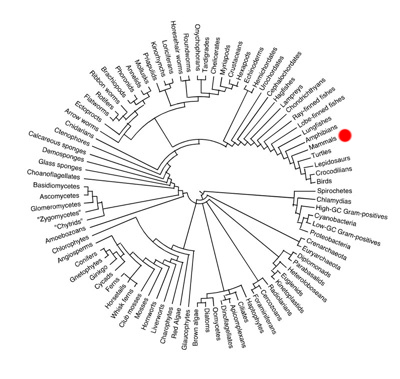Circle of Life
Life is complicated. We inhabit the same tangled network of life, but have different ways of living. We are all connected in real ways. We all — and here I mean all living creatures on earth — share common ancestors. Somewhere back in time you share a relative with a snail, a fern, a clam, and a mite. The only true map of this jumbled ancestry in time would be a chart that showed the heritage of every single individual organism that ever lived — and obvious impossibility.
Short of that precision, ANY other map of the relationships between creatures is a piece of poetry, no matter what scientific journal it appears in. There is no tree of life that is true. Every category we cast organisms into, including the category of species, is a handy idealization. We use ideal notions like species to reduce the “impossible” complexity of historical relationships into something simple enough that we can look at. Without the gross exaggerations of what we call “species,” we could not begin to see the connections between creatures. Yet every view of how species relate in time is warped and wrong in some way.
Even DNA sequencing will not erase this cloud of uncertainty. Instead DNA sequencing will strongly reveal the gross approximations that species, as a category, actually are. However DNA gives us a new strongly consistent warped view of species, a view which can be applied across all types of organisms. The DNA view is more consistent than evaluating the shape and similarity of body parts, but poetry still.
The orthodox map of the relationships between varieties of life is the Tree, as in the Tree of Life. This “arboreal” metaphor is okay because it is so easy to hold in our primeval minds, but there is a better metaphor for this history. Biologist David Hillis, MacArthur award grantee, has been developing a fantastic “circle of life” view of all life based on DNA (actually rRNA) sequences. It retains some characteristics of the tree, but bent around into a circle so that it has no beginning, no end. It looks like this:

A simplified version looks like this:

In the center is the hypothetical ur-organsim, ancestor of all living creatures today. All creatures today form the rim of the circle’s circumference. In between the rim and the center are the zillions of intermediary fossils who once lived on this planet. You are at place where the U in the red dot points to.
There are several advantages to this view. Because of the circle, no organism is privileged with being above another. A circle has not top. We humans are somewhere in the lineup, but where depends on how you turn the chart. This circle of life also better captures the idea that all living organisms today are equally evolved. By definition, any organism alive today (shown on the outer rim) can boast an unbroken chain of ancestors who have survived the same number of years, 4.5 billions years. The snail, fern, clam and mite have all undergone an equally long path to now. They are all the results of 4.5 billion years of evolution. The fern’s 4.5 billion-year answer to how to survive is to steal energy from the sun; the snail to steal it from the fern; the mite to steal it from the snail, and the deep vent clam, to steal it from the heat of the earth. Humans have yet another set of answers, but we’ve also needed 4.5 billion years to think of them.


